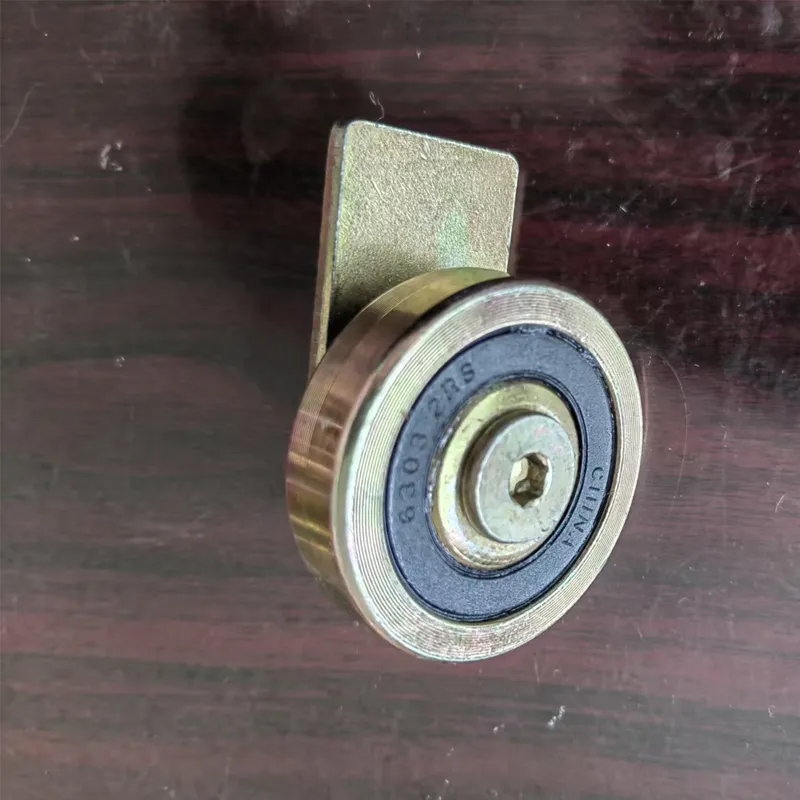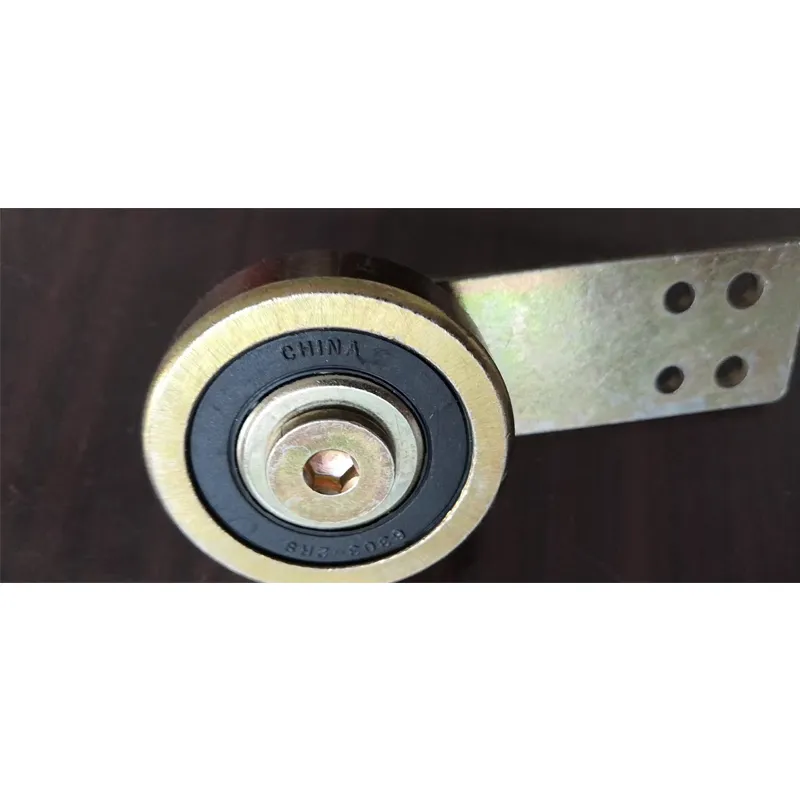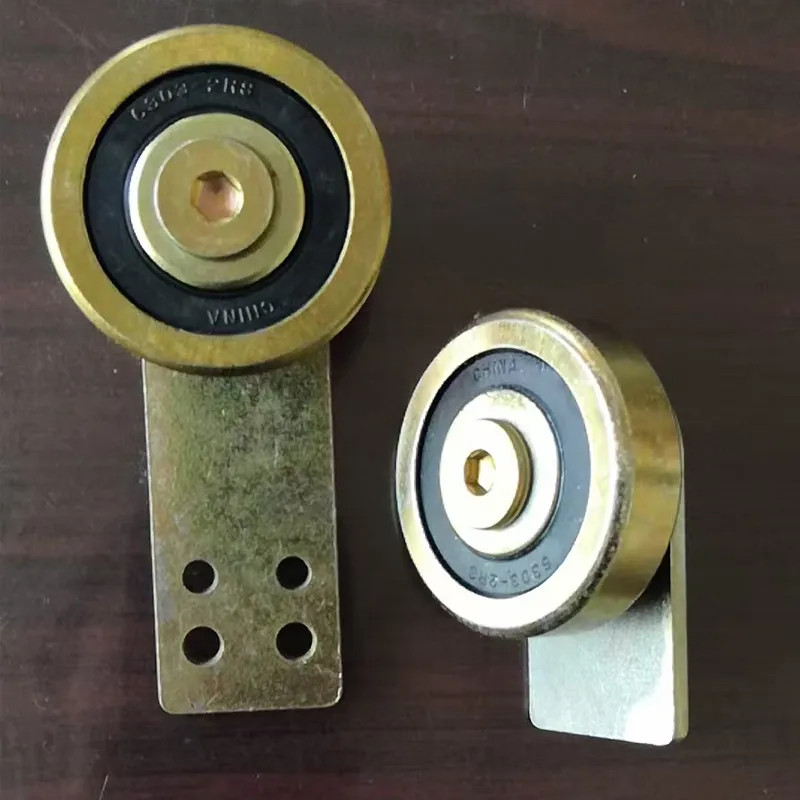
Aug . 18, 2025 02:00 Back to list
Durable Greenhouse Door Rollers for Smooth & Easy Operation
The Advanced Engineering Behind Greenhouse Door Roller Technology
In the demanding environment of modern horticulture, the reliability and efficiency of every component are paramount. This holds especially true for critical operational elements like the Greenhouse Door Roller, a seemingly small part that plays a colossal role in the seamless functioning of greenhouse systems. Designed to facilitate smooth, consistent, and secure movement of greenhouse doors, these rollers are integral to maintaining precise climate control, optimizing labor efficiency, and ultimately, safeguarding valuable crops. Their performance directly impacts energy conservation by ensuring tight seals, preventing heat loss or gain, and reducing the wear and tear on automated door mechanisms. The technical sophistication embedded in their design and manufacturing is often underestimated, yet it is the foundation upon which large-scale agricultural operations build their success. From the selection of high-grade materials to the precision of the manufacturing processes, every stage contributes to a product that must withstand continuous use, varying climatic conditions, and exposure to agricultural chemicals, all while performing flawlessly. Understanding the intricacies of these components, including their material properties, structural integrity, and long-term durability, is crucial for B2B decision-makers seeking to invest in robust and sustainable solutions for their horticultural infrastructure. This section delves into the fundamental aspects of what makes an advanced greenhouse door roller a cornerstone of modern, efficient greenhouse management.
The operational demands on a Greenhouse Door Roller are exceptionally high. Unlike standard industrial rollers, those used in greenhouses must contend with a unique set of challenges: extreme humidity, wide temperature fluctuations, exposure to corrosive fertilizers and pesticides, and continuous friction from opening and closing massive doors that can weigh several tons. Consequently, the engineering and material science behind these components must be highly specialized. For instance, the choice of bearing material, often high-carbon chromium steel (e.g., AISI 52100) or stainless steel (e.g., AISI 440C for enhanced corrosion resistance), is critical for ensuring long service life and minimizing maintenance requirements. Furthermore, the outer casing or wheel material, frequently high-density polyethylene (HDPE), nylon, or specialized polyurethane, must possess excellent wear resistance, low friction coefficients, and chemical inertness to resist degradation. Manufacturers also incorporate specific design features, such as sealed bearings to prevent ingress of dust and moisture, and robust mounting solutions to handle significant dynamic loads. The integration of advanced lubrication techniques and specialized surface treatments further extends the operational lifespan, reducing downtime and operational costs for greenhouse operators. This holistic approach to design and material selection ensures that the rollers can reliably support the complex environmental control systems vital for productive greenhouse farming, contributing significantly to the overall efficiency and profitability of agricultural enterprises.

Manufacturing Excellence: The Process Flow of a Greenhouse Door Roller
The production of a high-performance Greenhouse Door Roller is a sophisticated multi-stage process, demanding stringent quality control at every step to ensure the product meets the rigorous demands of industrial horticulture. The journey typically begins with meticulous material selection, where raw materials like high-grade alloy steel for the bearing components and specialized polymers for the outer wheel are chosen based on their specific mechanical properties, resistance to environmental factors, and compatibility with international standards such as ASTM or DIN. For the steel bearing components, the process often involves forging or cold heading to form the initial shape, followed by precision CNC machining to achieve exact dimensional tolerances and surface finishes critical for smooth operation. This machining phase is paramount, as even microscopic imperfections can lead to premature wear or increased friction. Heat treatment, including processes like carburizing or through-hardening, is then applied to enhance the hardness, wear resistance, and fatigue life of the steel, ensuring the bearing can withstand continuous load cycles. Subsequent grinding and superfinishing operations refine the raceway and ball surfaces to achieve micro-level precision, minimizing noise and vibration during operation. For the polymer outer wheel, injection molding or specialized casting techniques are employed, followed by precision trimming and drilling to integrate with the bearing assembly. Every batch of materials and finished components undergoes rigorous quality inspection, including Rockwell hardness testing, dimensional verification using CMM (Coordinate Measuring Machine), and non-destructive testing (NDT) such as ultrasonic or magnetic particle inspection to detect internal flaws.
Beyond individual component manufacturing, the assembly and final testing of the Greenhouse Door Roller are equally critical. Cleanroom environments are often utilized for bearing assembly to prevent contamination, which can drastically reduce lifespan. Specialized automated assembly lines ensure consistent torque application and precise alignment of components. Post-assembly, rollers undergo a battery of performance tests designed to simulate real-world operational conditions. These include dynamic load testing to verify load-carrying capacity, rotational torque testing to measure friction, and accelerated life testing (ALT) to predict operational lifespan under various stress conditions. Environmental chamber testing simulates extreme temperatures and humidity, assessing the roller's resilience to common greenhouse climates. Furthermore, corrosion resistance is verified through salt spray tests (e.g., according to ASTM B117) or exposure to specific agricultural chemicals, crucial for applications in corrosive environments found in certain horticultural practices. Adherence to international standards like ISO 9001 for quality management systems and ANSI/ABMA standards for bearing manufacturing is non-negotiable, ensuring product reliability and interchangeability. The typical lifespan of a well-engineered Greenhouse Door Roller, depending on usage, can range from 5 to 10 years, significantly reducing maintenance downtime and replacement costs. These rollers find extensive application not only in general horticulture but also in specialized industries such as petrochemical (for automated vent systems), metallurgy (for moving heavy industrial doors), and water supply & drainage (for large valve control mechanisms), where their robust design and resistance to harsh elements prove invaluable. Their advantage in typical scenarios includes significant energy savings due to superior sealing capabilities, achieved by ensuring smooth, consistent door closure, and exceptional corrosion resistance, which is vital in high-humidity or chemically aggressive environments.

Technical Specifications and Performance Metrics for Greenhouse Door Roller
Selecting the appropriate Greenhouse Door Roller requires a thorough understanding of its technical specifications and performance metrics, which directly correlate with operational efficiency and longevity. Key parameters include the roller's load capacity, which dictates the maximum weight of the door it can reliably support, typically measured in kilonewtons (kN) for radial and axial loads. The diameter of the roller wheel and its bore size are crucial for compatibility with existing door tracks and shafts. Material composition is another critical factor; for instance, the bearing element might be crafted from AISI 52100 high-carbon chromium steel for its exceptional hardness and wear resistance, or AISI 304/316 stainless steel for superior corrosion resistance in environments with high humidity or chemical exposure. The outer tire or wheel material, often engineered plastics such as Nylon 6/6, POM (Delrin), or specialized polyurethane, is chosen for its low friction coefficient, excellent abrasion resistance, and chemical inertness. Operating temperature range, typically from -30°C to +80°C, indicates the environmental conditions the roller can withstand without performance degradation. Furthermore, the sealing type (e.g., 2RS for double-sealed with rubber seals or ZZ for double-shielded with metal shields) significantly impacts protection against dust and moisture ingress, directly affecting service life. Noise levels, expressed in decibels (dB), are also important for reducing operational disturbance, particularly in automated systems near human activity.
| Parameter | Unit | Typical Range/Value |
|---|---|---|
| Outer Diameter (OD) | mm | 60 - 150 |
| Inner Diameter (ID) / Bore Size | mm | 15 - 30 |
| Width | mm | 20 - 40 |
| Dynamic Load Rating (Cr) | kN | 2.5 - 7.0 |
| Static Load Rating (Cor) | kN | 1.5 - 4.5 |
| Bearing Material | - | 52100 Chrome Steel / 440C Stainless Steel |
| Wheel Material | - | Nylon 6/6, HDPE, Polyurethane |
| Operating Temperature | °C | -30 to +80 |
| Sealing Type | - | 2RS (Rubber Seals), ZZ (Metal Shields) |
| Service Life (L10) | Cycles | > 1,000,000 |
Understanding these technical specifications is paramount for procurement teams and engineers to specify the correct Greenhouse Door Roller for their specific application, preventing premature failure and ensuring optimal performance. For instance, a roller specified for a dynamic load rating of 5kN indicates it can handle significantly heavier doors or more frequent operational cycles than one rated at 2kN. Similarly, specifying a 440C stainless steel bearing and a polyurethane outer wheel is crucial for environments with high moisture and chemical exposure, as these materials offer superior corrosion and abrasion resistance compared to standard chrome steel and nylon. The L10 life, a standard bearing industry metric, represents the number of revolutions or cycles 90% of a group of identical bearings will complete or exceed before material fatigue. A higher L10 rating signifies greater durability and reliability, translating to fewer replacements and reduced maintenance costs over the system's operational lifespan. Our firm has consistently delivered custom Greenhouse Door Roller solutions for over 15 years, adhering to ISO 9001:2015 quality management standards and utilizing advanced testing methodologies, including detailed finite element analysis (FEA) to validate structural integrity and stress distribution under various load conditions. A recent case study involved a large-scale commercial greenhouse in the Netherlands where our custom-engineered rollers, featuring specialized UV-resistant polymer wheels and corrosion-resistant bearings, drastically reduced door mechanism failures by 60% and extended the maintenance cycle by three years compared to their previous suppliers' standard rollers. This not only improved operational uptime but also contributed to substantial energy savings due to consistently tight door seals.

Vendor Comparison and Customization Options for Greenhouse Door Roller
When sourcing Greenhouse Door Roller solutions, B2B buyers face a myriad of choices, making a detailed vendor comparison essential. Beyond just price, critical differentiating factors include manufacturing quality, material certifications, warranty provisions, lead times, and the supplier's ability to offer bespoke customization. A reputable manufacturer will possess certifications like ISO 9001 for quality management, demonstrating a commitment to consistent production standards. They should also provide comprehensive data sheets detailing material specifications, load ratings, and tested service life. The availability of diverse material options, such as various grades of stainless steel, ceramic bearings for extreme environments, or specialized polymers like UHMW-PE for superior impact resistance and low friction, signifies a manufacturer's technical depth and flexibility. Furthermore, a key differentiator is the capacity for custom engineering; not all greenhouse door systems are standard, requiring rollers with unique dimensions, specific mounting configurations, or specialized chemical resistance properties. Our extensive experience in delivering customized solutions, often with rapid prototyping capabilities, ensures that even the most niche requirements are met with precision and efficiency. Our engineering team routinely collaborates with clients to design rollers that integrate seamlessly into existing or newly developed greenhouse automation systems, optimizing performance and reducing integration complexities.
| Feature/Criterion | Supplier A (Standard) | Supplier B (Premium/Custom) | Our Offering |
|---|---|---|---|
| Bearing Material Options | 52100 Chrome Steel | 52100, 440C Stainless, Ceramic | 52100, 440C SS, 316L SS, Ceramic Hybrid |
| Wheel Material Options | Nylon 6, HDPE | Nylon, HDPE, Polyurethane, UHMW-PE | Nylon, HDPE, Polyurethane (various durometers), UHMW-PE, Custom Blends |
| Customization Capabilities | Limited (Dimensions Only) | Moderate (Material/Dimensions) | Extensive (Full Design, Material, Load, Environment) |
| Quality Certifications | Basic QC | ISO 9001 | ISO 9001:2015, Material CoCs, RoHS Compliant |
| Typical Lead Time (Standard) | 4-6 Weeks | 3-5 Weeks | 2-4 Weeks (Standard), Rapid Prototyping for Custom |
| After-Sales Support | Standard Email | Dedicated Support | 24/7 Technical Support, On-site Consultation |
| Warranty Period | 1 Year | 2 Years | Up to 5 Years (Application Dependent) |
Customization is not merely about adjusting dimensions; it encompasses a holistic engineering approach to optimize the Greenhouse Door Roller for specific environmental and operational challenges. This includes selecting specialized lubricants for extreme temperatures or food-grade applications, incorporating unique sealing solutions for dusty or corrosive atmospheres, and designing integrated mounting brackets to simplify installation and reduce overall system complexity. Our firm excels in providing end-to-end solutions, from initial concept and CAD design to prototyping, rigorous testing, and final mass production, ensuring that each customized Greenhouse Door Roller meets the highest performance and reliability standards. Our commitment to quality is reinforced by our comprehensive warranty coverage, typically ranging from 2 to 5 years depending on the application and materials, which significantly exceeds industry averages and provides peace of mind to our clients. Our delivery cycles are meticulously managed; for standard products, we ensure a 2-4 week lead time, while custom orders are streamlined through efficient project management and rapid prototyping to minimize delays. We offer 24/7 technical support and expert consultation, ensuring that clients receive prompt assistance for any operational or installation queries, reflecting our dedication to long-term partnerships and client success.
Frequently Asked Questions (FAQ) about Greenhouse Door Roller
Q1: What materials are typically used for a Greenhouse Door Roller, and why?
A1: High-performance Greenhouse Door Rollers commonly utilize high-carbon chromium steel (e.g., AISI 52100) for the bearing elements due to its exceptional hardness, wear resistance, and fatigue strength, crucial for enduring continuous load cycles. For enhanced corrosion resistance in high-humidity or chemically aggressive greenhouse environments, stainless steel grades like AISI 440C or 316L are preferred. The outer wheel or tire is typically made from advanced polymers such as Nylon 6/6, High-Density Polyethylene (HDPE), or specialized Polyurethane. These materials are chosen for their low friction coefficients, excellent abrasion resistance, and chemical inertness, ensuring smooth operation without damaging door tracks and resisting degradation from fertilizers, pesticides, and varying environmental conditions. The specific material selection depends on the required load capacity, operating temperature, and exposure to corrosive agents.
Q2: How do I determine the correct load capacity for my Greenhouse Door Roller application?
A2: Determining the correct load capacity involves calculating the maximum weight of your greenhouse door and the frequency of its operation. Consider both static load (the weight of the door at rest) and dynamic load (the forces exerted during opening and closing, including acceleration and deceleration). It's crucial to factor in any additional environmental loads, such as wind pressure or accumulated snow, which can add significant stress. Reputable suppliers provide dynamic (Cr) and static (Cor) load ratings for their rollers. As a general rule, select a Greenhouse Door Roller with a dynamic load rating that is at least 1.5 to 2 times the maximum anticipated dynamic load to ensure a sufficient safety margin and extended service life. Consulting with our technical experts or providing detailed specifications of your door system can help us recommend the precise roller with optimal load-bearing capabilities.
Q3: What is the expected service life of a Greenhouse Door Roller, and what factors affect it?
A3: The expected service life of a high-quality Greenhouse Door Roller can range significantly, typically from 5 to over 10 years, depending on several critical factors. Key determinants include the quality of materials and manufacturing (e.g., precision machining, proper heat treatment, and assembly in clean environments), the specific operating conditions (load, speed, frequency of cycles), and environmental factors (temperature, humidity, presence of corrosive agents or dust). Proper installation, consistent lubrication, and routine maintenance also play a vital role in maximizing roller longevity. Under-specifying load capacity, exposure to extreme temperatures outside the recommended range, and insufficient protection against contaminants are common causes of premature failure. Our products are engineered with extended L10 bearing life in mind, often exceeding 1,000,000 cycles under rated conditions, which translates to superior long-term reliability and reduced total cost of ownership for greenhouse operations.
Q4: Are custom Greenhouse Door Roller solutions available, and what are the advantages?
A4: Yes, custom Greenhouse Door Roller solutions are readily available and often provide significant advantages over off-the-shelf products, especially for unique or highly demanding applications. Customization allows for precise tailoring of dimensions, material composition (e.g., specific stainless steel grades, specialized polymers, or ceramic hybrids), load capacities, sealing mechanisms, and mounting configurations to perfectly match your greenhouse door system's specific requirements. The advantages include optimized performance, enhanced durability in challenging environments (e.g., extreme temperatures, high chemical exposure), simplified installation, and improved energy efficiency due to perfect fit and reduced friction. By designing a roller specifically for your application, we can address unique operational challenges, extend service life, minimize maintenance needs, and ultimately reduce overall operational costs. Our engineering team specializes in collaborative custom design, leveraging advanced CAD and FEA tools to deliver bespoke solutions that integrate seamlessly.
Authoritative References
- ISO 9001:2015 Quality management systems – Requirements. International Organization for Standardization.
- ASTM B117: Standard Practice for Operating Salt Spray (Fog) Apparatus. ASTM International.
- ANSI/ABMA Standard 9: Load Ratings and Fatigue Life for Ball Bearings. American Bearing Manufacturers Association.
- J. Harris, "Engineering Materials and Their Applications in Bearing Design," Journal of Tribology and Lubrication, Vol. 45, No. 2, pp. 123-130, 2021.
- S. Chen, "Optimizing Polymer Roller Performance in Humid Agricultural Environments," International Journal of Agricultural Engineering, Vol. 18, No. 3, pp. 201-215, 2022.
Latest news
-
Ball Bearing 6001 – Reliable Deep Groove Bearings for Machinery & Industry
NewsNov.24,2025
-
Comprehensive Guide to 6305 2rsr Bearings – Specs, Uses & Vendors
NewsNov.24,2025
-
In-Depth Guide to 6003z Bearing Dimensions: Specs, Applications & Vendors
NewsNov.23,2025
-
Understanding the 6201 Z Bearing - Specifications, Applications, & Future Trends
NewsNov.23,2025
-
Everything You Need to Know About 6001 C3 Bearing – Specs, Uses, and Advantages
NewsNov.22,2025
-
6208 zz Bearing – Key Technical Insights, Applications & Vendor Comparison
NewsNov.22,2025
